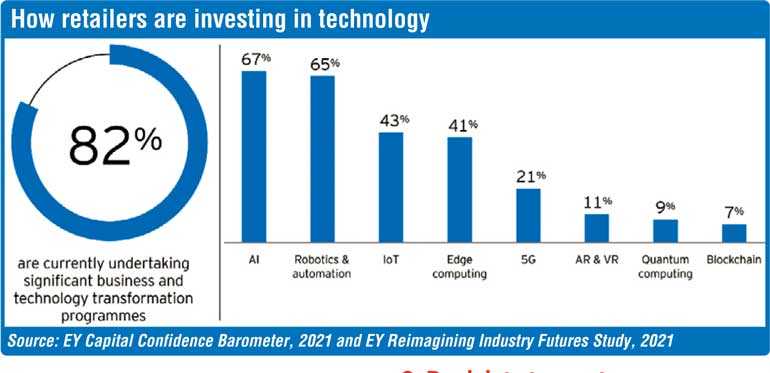Sunday Dec 07, 2025
Sunday Dec 07, 2025
Wednesday, 12 May 2021 00:00 - - {{hitsCtrl.values.hits}}

 |
| EY Consulting Leader for Sri Lanka and Maldives Arjuna Herath |
 |
| Ernst and Young Sri Lanka Senior Director, Technology Consulting Shanaka De Silv |
Traditionally, retailers always had a strong hold in people’s hearts as the go-to destination to grab essentials, pick up a treat, get advice and spend time with friends. But, over time, those levels of familiarity and trust have weakened as the scope, scale and variety of the sector has grown alongside the shifting volume of visiting customers.
In today’s context, retailers must work towards recapturing that authentic spirit of retail, which means becoming truly integrated into the lives of customers, but this time at scale – not delivered perfectly in a pilot but rolled out across the business as the ‘normal way that we do business.’
For this it requires a fundamental shift in how retailers view and implement technologies. The traditional front and back office divide must be replaced with a more holistic approach that is accretive to the experience’s retailers need to deliver to customers and employees.
The new strategic mindset for customer integration
EY’s Capital Confidence Barometer, 2021 and EY Reimagining Industry Future Study 2021 indicates 82% of retailers are currently undertaking significant business and technology transformation programs with greater focus on AI (67%), and Robotics and Automation (65%).
While retailers have invested heavily in digital technologies, few have pursued those strategies with true consumer integration in mind. Creating a shopping app with augmented reality (AR) capabilities, developing in-store navigation and advice bots, and improving internal processes through automation are all exciting steps on the way, but they are not the destination. Instead, retailers must integrate core technologies directly and seamlessly with the consumer.
Digital-first entrants are a proof of concept for this approach the New entrants have only scratched the surface of the value that can be unlocked by this approach. Having had the luxury of building systems from scratch, Digital-first entrants’ strategic value propositions are tailored explicitly to meet today’s flexible and highly personalised customer expectations. Without having the distraction of only using technologies to cut costs and achieve process inefficiencies, their malleable digital infrastructures have enabled them to rapidly deploy and develop new offerings based on accurate, enterprise-wide flows of customer data.
While strategies are enabled by technologies, crucially they have people at their heart. They unite the consumer and the retailer in real time so that insights generated by the continuous flow of data can rapidly generate improvements and innovation in services, information sharing and experiences.
Creating a core to the business that adds continual value
EY Consulting Leader for Sri Lanka and Maldives Arjuna Herath says, “New entrants have only scratched the surface of the value that can be unlocked by this approach. Often, they have cherry-picked niche markets or products and remain relatively small-scale businesses. In that respect, traditional retailers with strong brand awareness, established trust, and larger customer bases are in a much better position to benefit from integrating into consumer lives at scale.”
Yet, legacy technology infrastructures are often scattered across the enterprise and have been made to work with newer technologies where necessary. And because systems do not work well together easily, building creative value propositions that truly integrate with the customer is much harder and often more expensive to achieve. The transformation of legacy technology infrastructures is the foundation. Despite both the unattractive and difficult investments required what is needed is to build creative value propositions that truly integrate with the customer.
Fortunately, the same rapid decision-making strategies that many retailers have adopted to face COVID-19 pandemic can come into play. By understanding the needs of their customers, retailers built the right partnerships and implemented the right technologies to deliver value. Some of those projects provided more integration with loyal customers through new apps, technologies and marketing know-how than had existed before. This can be seen in a renewed focus on investing heavily in digital technologies as businesses emerge from the pandemic (see stats below from the EY Capital Allocation Survey 2021).
An approach that would truly help transform
Taking an approach that transforms and streamlines core technologies is the next crucial step. Herath says, “Agile projects aimed at collapsing data silos and unifying broken lines of communication are likely to add greater value to the customer than a pilot of an untested technology in a remote part of the business.”
Herath further stated, “Data from all customer touchpoints across the enterprise must be available centrally in real time to every part of the business and applied to improving further integration and operational excellence. For example, it becomes simpler to identify and tackle decision points in the customer journey that can be better informed by data or improved or automated by the technology team. Retailers without this clarity should resolve it as their number one priority.” Herath reiterated, “Once the foundation is solid, any new technologies that are introduced will benefit from smooth integration and rapid deployment.”
Putting operational excellence at the service of the consumer
The shift in thinking from what the technology can do to how it can serve the consumer’s needs is important. Achieving such operational excellence means that the customer gets every bit of value from the technologies and processes that a business uses (as well as the business).
Commenting on this Ernst and Young Sri Lanka Senior Director, Technology Consulting Shanaka De Silva said, “If a retailer can command these technologies from within the core of the business to structure, organise, share and understand the data that customers generate, it can use those insights to invent new factor combinations that have not previously existed but are directly relevant to customer needs and aspirations. That may include, for instance, revitalising bricks and mortar stores by integrating them with a wide range of human and digital capabilities – from advice bots, apps and store navigators, to self-checkout and virtual reality, staff curated experiences.”
Focusing on what consumers value is critical to this process. EY sees three fundamental expectations: make my life easier, make it feel better, or make it more fulfilling. These create three areas of opportunity for a retailer to become an integrated part of the customer’s life: become invisible, become indispensable, or become an intimate part of their life experience (someone the customer wants to spend time with).
Retailers must develop the right mix for their business as well as the right blend of model and formats to deliver them, based on their strengths and capabilities. Having the power and flexibility to create and manage such complexities is key to unlocking true customer integration.
Integrating dynamic value propositions aligned to strategy
Increasingly, the technology that delivers value to customers is the same technology that runs the business. De Silva added: “With both customer and operational data shared beyond siloes and accessible centrally, technology enables retailers to bring consumers credible value propositions – ones that are best rooted in the business’ own identity, integrated back into the business and relevant to their customers’ lives.”
De Silva further stated: “Auto-replenishment, virtual reality experiences and click and collect partnerships. For example, work best in a framework that is meaningful to the way customers live and embedded in how the business operates. Without this context, they are in danger of becoming merely fancy, expensive add-ons that are difficult to scale and deliver questionable value.”
EY reports this is why routes to customer integration must be delivered by strategies that are created in the context of the three value propositions. For those who see weekly grocery shopping as a chore, they will want to save time and will be happy to see online shopping baskets auto replenished, sensible digital navigation in store and perhaps an option to click and collect somewhere convenient on the way back from a school run or perhaps as day ends. Someone organising a party may enjoy using an app provided by their retailer that brings together local musicians, food, drink and venues under an easy-to-use umbrella to solve the problem. Or for those who want to check out the latest fashions, they may enjoy a trip to a store that offers augmented reality mirrors, virtual reality displays and integrated social media experiences to share with friends.
With a powerful suite of technologies that work seamlessly the opportunity for retailers to create compelling propositions that blend all three dimensions in ways that are most relevant to the consumer appears limitless.
Creating successful technology strategies to integrate into consumer lives
Retailers must bring together the technologies that serve customers with those that run the business to drive value for both, if they are to integrate into consumer lives. Here are five strategic considerations:
1.Deliver technology with humans at the centre
Technologies and processes are vital, but only half the story. Successful technological transformations require an approach that has humans at the centre. Customer data represents the real experiences of people interacting with the business – often with employees. Improving technologies and processes is a journey that brings along both customers and employees alike and empowers their relationships seamlessly and effortlessly.
2. Create a foundation of operational excellence
Ensure the business’ core technologies and processes consistently meet the desired performance your value propositions demand. Once in place, it becomes easier to enhance offerings or deliver new ones with confidence that expectations will be met to today’s standards at the very least. Creating operational excellence is critical to the business due to scarcity of resources. Hence, best resources must be focused on these scalable projects in order to drive transformation at the heart of the enterprise.
3. Pool data to create one version of the truth
Capture business data alongside customer data in a central data lake to holistically analyse performance, behaviours and trends. Provide access to master data across the entire business generating actionable insights to drive customer engagement and experience, and operational decisions and innovation.
4. Prioritise customer value above individual cost
Focus on the profitability of the whole technology ecosystem and the contribution individual technologies make towards generating customer value. Looking at the profitability of individual technology projects in isolation will not give you a complete understanding of the contribution they make to the customer or the business. Use technology to build its own business case by understanding the systemic value it will bring to the enterprise, rather than building a business case for the technology in siloed initiatives.
5. Shift mindset
Enable executive management to control the technological transformation agenda so that agile pilots support the business’ long-term strategic objectives. Carefully consider the business’ own strengths and identity and create a values-based digital business model supporting a vision of the future. Leverage the complexity of technologies and processes to create new factor combinations and new value propositions that customers value.
Conclusion
To recapture the authentic spirit of retail, businesses need to integrate with the lives of their customers at scale. That entails following three possible routes: invisibility, indispensability and intimacy. Creating a business that meets those expectations demands operational excellence in core technologies and processes.
Uniting the technologies that serve customers with those that run the business into a streamlined whole brings power, flexibility and relevance to its value propositions and empowers its people. Because operational excellence is enterprise wide, retailers can seamlessly blend those offerings and experiences at scale in ways that were previously unthinkable.